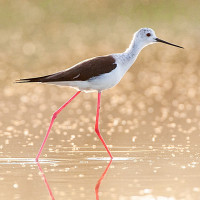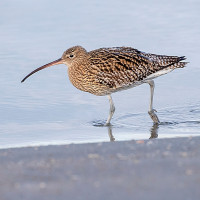Description
The Stagnone islands are a small archipelago consisting of only 4 islands, separated by very shallow water, which never manages to exceed 2 meters in depth. In several points it is just 50 cm , which makes it possible to literally walk from one island to another. Isola Grande is the largest island of this mini-archipelago. Today there are some abandoned salt pans, a forest and some beaches of fine sand. The birdlife is particularly good for migrating birds, but there are also many breeding birds. Among the birds you can encounter are Silkehejre, Sort Ibis, Storspove, Skestork, Stor Præstekrave, Hvidbrystet Præstekrave, Stylteløber, Stor Flamingo, Dværgterne, Rørhøg and Fiskeørn. During the colder months you can spot ducks like Atlingand, Spidsand, Krikand and Taffeland.
_________________________
Italiano: L'Isola Grande, detta anche Isola Lunga o Altavilla, è un'isola posta nel territorio di Marsala, comune italiano del libero consorzio comunale di Trapani in Sicilia. È la più grande isola del miniarcipelago delle isole dello Stagnone. La sua formazione, piuttosto recente, ha dato origine alla laguna. Era formata da isolotti rocciosi, che si unirono formando la lunga isola, probabilmente per l'allargamento dei depositi di sale molto sfruttati fin dai tempi dei Fenici. Da una mappa del XVI secolo si evince che era composta da 5 isolette (Frati Janni, Altavilla, Burrone, Sorci e San Todaro) unite da canali. Vi si trovano oggi alcune saline in stato di abbandono, un bosco e alcune spiagge di sabbia fine.
Nella riserva naturale dello Stagnone si potranno ammirare numerose specie di uccelli come il Cavaliere d'Italia, il Corriere grande e piccolo, il Fratino e soprattutto i Fenicotteri Rosa. Inoltre già durante il mese di Luglio sarà anche possibile imbattersi negli uccelli migratori autunnali come i Magnattai e i Churlì dal becco ricurvo, con l'arrivo dei mesi più freddi invece si potranno avvistare le Marzaiole, i Codoni, i Germani Reali, le Folaghe, le Alzavole, Moriglioni e gli stormi di Anatre. Le specie di uccelli più facili da vedere nella riserva naturale dello Stagnone sono le Spatole, i Cormorani, le Garzette, gli Aironi Cenerini, il Falco Pescatore, il Falco di palude, il Gheppio e se si è veramente molto ma molto fortunati anche il Martin Pescatore.
Details
Access
The Stagnone Islands Nature Reserve is located about 8 km north of Marsala. To reach the reserve you can use the car along the Trapani-Marsala coastal road, and then follow the signs to the Historic Pier of Mothia, Monzia, where you can park and take the ferry, in Contrada Spagnola in Marsala, which will take tourists to the islands.
The Stagnone nature reserve can only be reached on foot. It is advisable to get off the ferry in a swimsuit and with shoes suitable for entering the water, which in any case being very low according to the sea conditions can reach either the knees or the waist. You can also book a guided boattour through the Stagnone lagoon (60 minutes, € 10 / person). On Isola Grande a 6 km path runs from north to south over the island.
_________________________
Italiano: Per raggiungere la riserva naturale dello Stagnone si potrà utilizzare la macchina percorrendo la strada litoranea Trapani-Marsala, per poi seguire le indicazioni che raggiungere l'Imbarcadero Storico di Mothia, Monzia, per arrivare al parcheggio prima di lasciare l'auto per prendere il traghetto, in Contrada Spagnola a Marsala, che condurrà i turisti alle isole.
La riserva naturale dello Stagnone è raggiungibile solamente a piedi attraversando un guado che parte da San Teodoro, infatti è consigliabile di scendere dal traghetto in costume da bagno e con delle scarpette adatte ad entrare in acqua, che comunque essendo molto bassa in base alle condizioni del mare può arrivare o alle ginocchia oppure alla vita.
.jpg)
.jpg)

